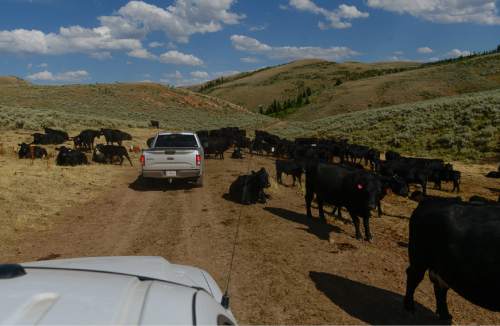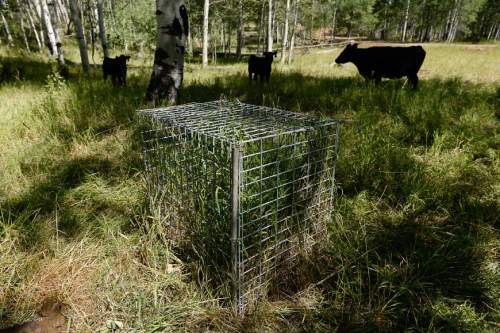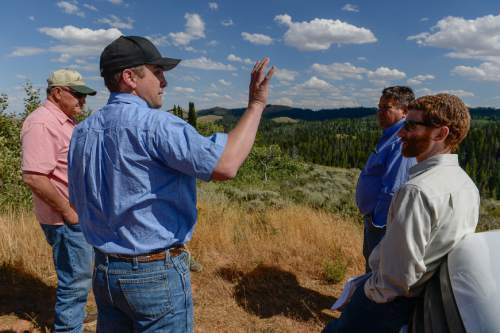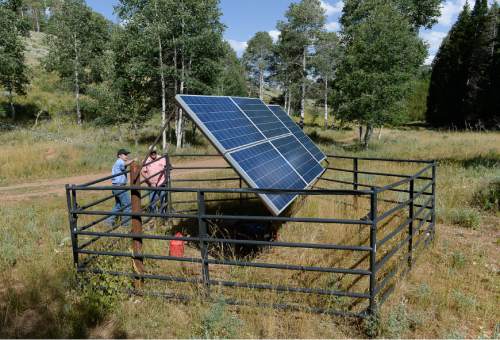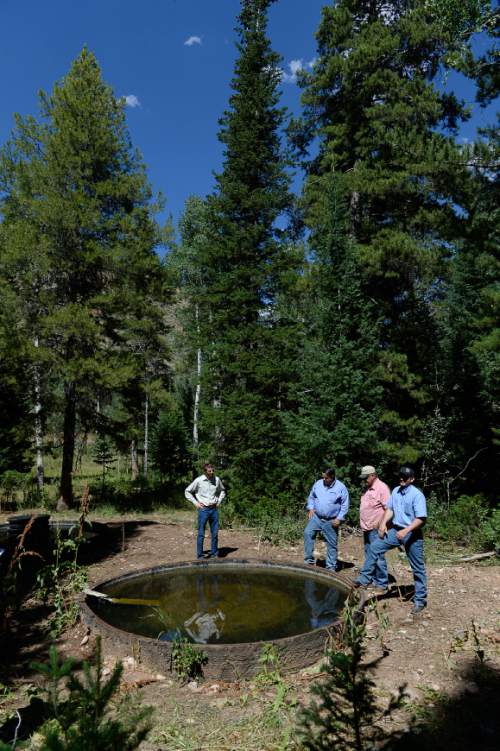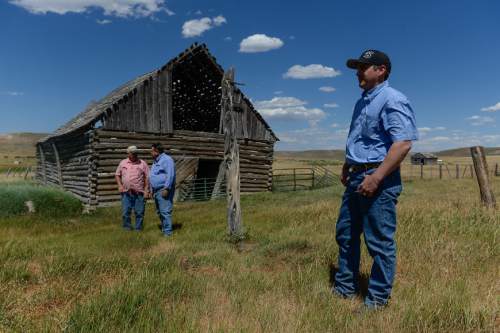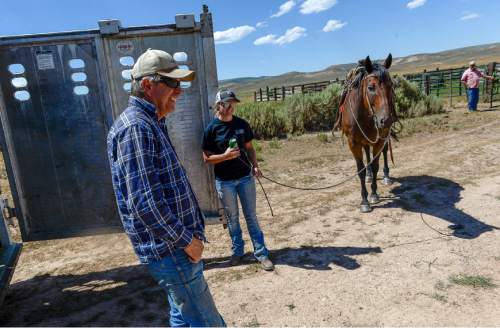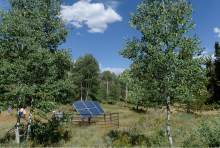This is an archived article that was published on sltrib.com in 2016, and information in the article may be outdated. It is provided only for personal research purposes and may not be reprinted.
Randolph • It is often said good fences make for good neighbors.
In one large northern Utah grazing district, fences are expected to play a key role in transforming the way public lands are managed. Cattle and sheep operators in Rich County may soon pool their herds for the summer grazing season in the hills rising west of Randolph under an idea hatched by rancher Alvin Shaul and his neighbors.
As a young man, after his dad sold the family ranch, Shaul went to work for Deseret Land and Livestock, which runs a cattle operation just south of Randolph on a large tract of private land. Deseret used a rotational system of pastures that left the range in better shape while producing lots of fat calves.
He and his wife went into business for themselves in the early 1970s. "I started with one cow and kept building. Eighty acres came for sale in Randolph and I bought it," said Shaul, who grazes 250 cows in the New Canyon allotment he shares with a dozen other ranchers.
Shaul is now putting into practice what he learned at Deseret, and he has the backing of his fellow ranchers, the Rich County Commission and the federal agencies that administer the Three Creeks region where 29 ranchers run livestock from May 15 to Sept. 15.
At the request of county commissioners, the Bureau of Land Management and the U.S. Forest Service are poised to consolidate 10 grazing allotments into one 135,000-acre management unit. After five years of study, the agencies have released a draft Environmental Assessment of the project and expect to issue a final decision by year's end.
The county-driven proposal stands in sharp contrast to the angry rhetoric coming from other ranching communities where public-land users complain federal "overreach" is putting them out of business and destroying the custom and culture of rural areas.
"We are not all Cliven Bundys. For people who are just watching the news, it's like all these ranchers don't want to pay their assessments and want to tell the federal government what to do," said Dale Lamborn, president of the Three Creeks Grazing Association. He also runs the local school district, and his ranching roots run deep into Rich County, stretching back into the homesteading era.
Instead of fighting federal oversight, the Randolph ranchers have chosen to work hand in hand with BLM and Forest Service officials.
"We are about building relationships and interagency cooperation with us and with private lands," Lamborn said. "That's the majority. We are about making it work for everybody."
—
'Time-controlled grazing' • Instead of grazing an entire allotment all summer, the ranchers intend to run two consolidated cattle herds, each 1,600-head strong, through fenced-off pastures for two or three weeks at a time. Then the pastures would be rested until the following year, even longer in some cases.
Known as "time-controlled grazing," this system requires far more active management and water improvements than a typical allotment, where permittees park their herds for an entire season.
The project area captures 9,000 acres of state trust lands and another 22,700 private acres, nearly all of it used for livestock grazing. These ranchlands spread up three drainages into the Monte Cristo Range west of State Route 16. Elevation ranges from 6,500 feet outside Randolph to 9,700 feet along the ridgetops.
"We are going to have the same number of cows on the landscape. We are just managing them differently for benefits for both ranchers and sage grouse," Matt Preston, the BLM's new Salt Lake City field office manager, said during a recent tour of Three Creeks with Shaul and Lamborn.
Three Creeks is within areas that are subject to new federal land-use rules designed to protect sage grouse habitat, implemented last year to keep the ground-nesting bird off the list of protected species. The BLM wants to demonstrate that livestock can coexist with sage grouse and other wildlife, Preston said.
Agriculture is the linchpin for Rich County's $24.3 million economy, accounting for half the local activity, according to a 2012 analysis conducted by Utah State University economists. Three Creeks livestock accounts for $2 million in annual production, representing 6 percent of the county's economic output when a multiplier effect is considered. The report concludes that the Three Creeks consolidation could increase nonagricultural activity by enhancing habitat for fish and wildlife, which would draw more sportsmen to Rich County.
State officials hope the Three Creeks consolidation will serve as a model for publicly owned grazing areas elsewhere in Utah and the West.
But some aren't sold on the consolidation. The premise of time-controlled grazing has been refuted by top range scientists, according to John Carter, of the conservation group Yellowstone to Uintas Connection.
No grazing system is effective "without first addressing the stocking rate and ensuring that it is based on the ecological needs of the native plants," he wrote in his group's formal comments.
Carter and others say federal agencies must restrict the percentage of available forage livestock may consume to ensure a sustainable amount of bluebunch wheatgrass, Indian ricegrass, Idaho fescue and other plants grow back in subsequent years.
"There's no requirement that plant communities recover before they are grazed again; it can take years," Carter said. "It's another shell game because the agencies can't confront the reality that the range can't sustain grazing."
Taylor Payne, a Randolph-based coordinator for the Grazing Improvement Program, run by the Utah Department of Agriculture and Food, contends it's the timing of the grazing that's important, not the amount of forage left behind.
The percentage of forage a herd eats "doesn't matter if you have enough time to recover," said Payne, who wrote his Utah State University master's thesis on Three Creeks. Under the new grazing regimen, Payne said, 70 percent to 80 percent of Three Creeks will be free of cows at any one time during the four-month grazing season.
Back in the 1960s, the BLM attempted to consolidate its five Three Creeks allotments, but the areas lacked the fencing and water conveyance to pull it off. Numerous pastures have been fenced off through the years as ranchers increasingly work together. Fourteen ranchers, including Lamborn and Shaul, have long since pooled their cattle onto the sprawling New Canyon allotment and have been practicing rotational grazing for the past few years.
As a result, Payne said, New Canyon is the BLM's most productive grazing allotment.
—
'They can take bullets and keep on going' • The Three Creeks proposal envisions watering the uplands to lure cattle out of riparian areas, the boggy sensitive zones that support so much of the West's biodiversity. Cattle tend to congregate at water sources, which can be harmful to riparian health, and some of streams are loaded with sediment. Some riparian areas have already been permanently fenced off by exclosures as large as 40 acres. The spots are valuable references, indicating how lands perform when they are never grazed.
Two of the creeks, Big and Sage, are listed as impaired waterways.
The Utah Department of Environmental Quality has provided a $1 million grant to the project in hopes of delisting these creeks.
The first stop on the ranchers' recent tour was a system of troughs constructed this year on a Forest Service allotment. The three 10-foot-diameter circular troughs were fashioned from huge tires recycled from mining trucks. The tires were sliced in half, laid on the ground and each filled with 1,300 gallons from a well equipped with a solar-powered pump a few miles away.
"They can take bullets and keep on going," Payne said, noting how the rubber tire walls self-seal after they have been hit by target shooters. Such vandalism, a stubborn problem on the open range, can leave a steel trough empty.
Each of the tires comes with a concrete escape ramp to allow an exit for any little critters that fall in.
The BLM and Forest Service intend to install 59 new troughs on the range, connected to water sources through 89 miles of pipelines routed under existing roads. Also to be installed are four water storage tanks and two wells. In contrast with the extensive water improvements, the 218 miles of existing fences will be increased by 5 percent to set off a total of 23 pastures.
Carter says all this new infrastructure, along with heavy concentrations of livestock, would "industrialize" the landscape.
"This is basically an open-ended process with no accountability to the public, and driven by permittees," Carter wrote.
Meanwhile, state officials are displeased that federal officials are not committed to restoring previously permitted stocking levels on Three Creeks. Currently, these allotments support 17,000 animal unit months — the amount of forage a cow-calf pair eats in a month.
This is about 60 percent of the use officially authorized on these allotments, but the BLM and Forest Service reduced stocking levels years ago to address degraded water quality.
Ranchers say the reduction failed to solve these problems, because the remaining cattle still congregate in creeks.
"The range is not necessarily overstocked," Payne said. "It's undermanaged."
BLM officials say the new grazing regimen will be closely monitored, and the stocking levels will be adjusted if warranted.
"This project allows us to think about the full landscape in our management," Preston said. "Rather than managing 29 permits in smaller areas, you are managing one or two across a huge area, you are able to move the livestock in a way appropriate for that huge area rather than having them circling for the whole season in one little area."
Once the agencies sign off on the plan, Three Creeks' 29 ranchers will form a limited liability corporation, or LLC, to manage their permits collectively.
The new grazing cooperative will employ horse-mounted "range riders" to move the cows between pastures and keep them from camping out in riparian areas. Ranchers have already outsourced fence maintenance to a contractor who repairs breaks every spring, sparing ranchers countless headaches.
"If one guy doesn't fix a fence," Lamborn said, "we all get in trouble if cows get into places they don't belong."
— Brian Maffly covers public lands for The Salt Lake Tribune. Maffly can be reached at bmaffly@sltrib.com or 801-257-8713. Twitter: @brianmaffly


